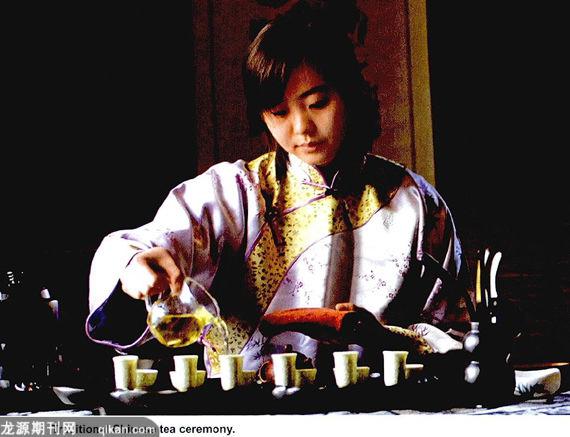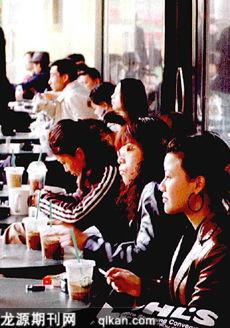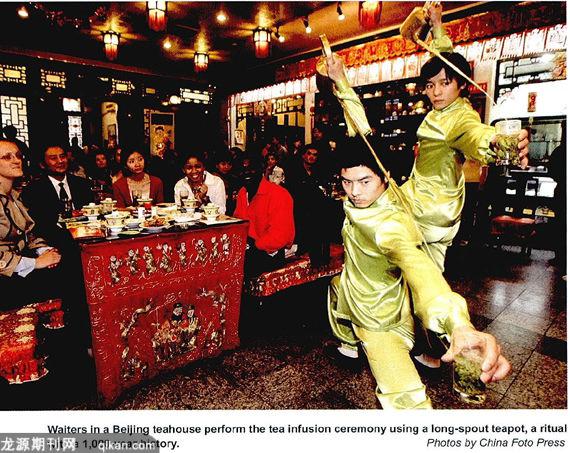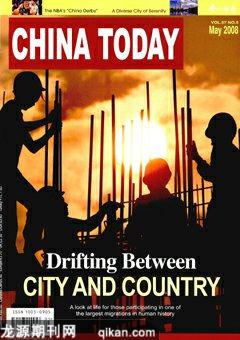Can Chinese Teahouses Imitate Starbucks?
staff reporter LIU QIONG
FEW things are as synonymous in the popular imagination as China and tea, and with excellent reason. Tea drinking in China can be traced back thousands of years, and the humble Camellia sinensis bush continues to be regarded as one of lifes basic necessities, right alongside rice, oil and salt.
An Old Habit in a Refined Ambience

Perhaps more importantly, tea is at the center of a multitude of elaborate cultural rituals which are as varied as the many ways the leaves can be brewed, and no self-respecting Chinese host would dream of receiving guests without serving some.
As with any staple, of course, affordability was always a given, and public teahouses were for the most part simple affairs – inexpensive and unpretentious – where ordinary people would meet with friends to pass the time of day. With Chinas spectacular emergence as an economic powerhouse, however, the teahouse has metamorphosed into a trendy and considerably more lucrative proposition, analogous to the chic cafes so endemic in the West.
Which is why something as simple as a cup of hot water with a few tealeaves in it has suddenly piqued the entrepreneurial interest of Chinas new business elites. In the first quarter of 2006, for example, the Beijing Administration for Industry and Commerce received over 300 applications for new teahouses, while figures from the China Tea Marketing Association show that the capital had more than 700 teahouses in 2004 – double the number just three years before.
“The year 2000 saw a mushrooming of teahouses,” said Yang Chunwu, assistant manager of the Wu Fu Teahouse, the first of the new-style establishments dedicated to promoting Chinese tea culture. “But there has also been an increasing homogeneity of products.”
Once, teahouses played a more traditional role – they served as salons for ordinary Beijingers, as noisy trade markets, as rendezvous for clansmen, even as clubs for bird lovers, not to mention as places to eat or get the latest news. When Yin Shengxi, who later established the well-known Lao She Teahouse, sold tea behind a stall in Qianmen Street in 1979, a cup of tea cost only two cents. Now, the average cost for a pot of tea has risen to RMB 50-100, and some teahouses actually charge by the hour.
In early 1994, when Wu Fu had just opened, people did not realize that it was different from traditional teahouses. “How much for a cup?” some old lady would ask as she came in laden with a vegetable basket, and would immediately turn away upon hearing the price. Wu Fu was hard pressed to make ends meet those first few months as it waited patiently for patrons.

But the new-fangled shop soon caught everyones attention, especially the medias. “The market was calling for teahouses like Wu Fu back then, but no one realized it yet,” said Yang, one of the first wait staff at Wu Fu. The media coverage had a salutary effect, and by the end of the year tea lovers sometimes had to wait their turn to be seated at Wu Fu.
Inevitably, investors soon followed, especially since the initial cost seemed so reasonable. Yang remembers how quickly teahouses began to spring up in imitation of Wu Fus formula, and yet some could only boast a handful of tea caddies and a dozens tea sets. Tea restaurants also began to appear, such as Be for Time and the Taiwan-based RBT.
“Few are outstanding or large-scale,” said Zheng Danyang, general manager of Beijing Franchise Consulting, “and the different positioning is a question worth considering.”
A Lesson from Starbucks
“There has been a Starbucks boom in China,” one blogger writes, “and sometimes I have a cup or two. But Chinese tea quenches my thirst better. It would be great if we could have a brand of teahouses spreading all over the world like Starbucks.”
Indeed, in a country known as the birthplace of tea, it is arguably a pity that no teahouse with a national brand name exists. And Starbucks seems to offer a ready model for future teahouses in China. “Tea and coffee are both mass consumer drinks. By following a consumer-oriented approach, both can spread by means of franchises,” the franchise expert Zheng said. “KFC, McDonalds and Starbucks are the successful early practitioners.”
Founded in 1971, the Seattle-based coffee giant now has more than 10,000 outlets worldwide, and Zheng regards the chain operation as the premier model for fledgling domestic teahouses. It is not the best coffee, he joked, but it is indisputably the most popular. People can find the familiar green logo everywhere – downtown, in shopping malls or highway rest areas. By standardizing their products, customers are able to enjoy a cup that tastes the same wherever they are.
Zheng believes that a Starbucks-like teahouse would definitely be profitable. “A standardized brand, a standard production process and a reasonable price provide customer convenience,” Zheng said. “Whats more, it would create jobs and promote tea drinking.”
Instead of a Starbucks sense of chic lifestyle, however, teahouses would emphasize traditional Chinese culture. Yang Chunwu, for instance, requires that all his staff be tea specialists. “Spreading Chinese tea culture is an important part of our work,” he said. “We have a unique process, from tea preparing to brewing.” Employees at Wu Fu can answer any question about tea they are asked, even difficult ones such as the origins of the names Scarlet Robe and Iron Goddess.
Tradition Adapts to
Modern Management

These days, customers who visit teahouses are not necessarily there because they are thirsty, and Yang, who once occupied a high-level position in a four-star hotel,attaches great importance to the needs of his clients and stresses quality service.
He constantly reminds his staff that it is customers who pay their salaries, not the boss, and when a group of guests enters, his employees have been trained to recognize which of them is the guest of honor.
In Yangs mind, Starbucks is not a competitor. “Tea and coffee are not the same,” he said. But one thing that Wu Fu and Starbucks do share is a commitment to know their customers.
In a Starbucks, cashiers must type in a clients sex and age before the cash register will open. Likewise, Wu Fu established a client database in 2005, and an analysis of the data has shown that 80 percent of the teahouses customers are males over 30. “What they require is a pleasant atmosphere to talk business and meet with friends.”
And Yang believes wholeheartedly in the Western standardized management system. Starbucks success in China, he feels, rests with its advanced management.
“China has the highest standards with regard to tea production,” Yang said, and he has added his own standard for tea selection and management. “Wu Fu has experienced specialists in the main producing areas to choose the best teas,” he said, adding that all franchises are required to purchase tea from the home office, thereby avoiding the tempation some may face to use substandard tea in an effort to cut costs.
As expected, Wu Fus good reputation has attracted numerous franchise applications over the past few years, and at first, Yang almost always gave the nod. Later, however, he came to realize that some franchises were not operating up to his exacting requirements. “They would imitate the design and decoration of the home shop, and purchase high-quality tea, but then would fail to adopt the companys culture and management.”
As a result, Yang decided to slow down his expansion, and to focus on training instead. Each year now, at least two courses are held especially for Wu Fus 13 franchises nationwide.
In addition, having received expressions of interest from Australia and Britain in the past two years, Wu Fu has now established a timetable to open its first two overseas branches soon. So whether its to be coffee or tea, it looks like the future belongs to the franchisee.

